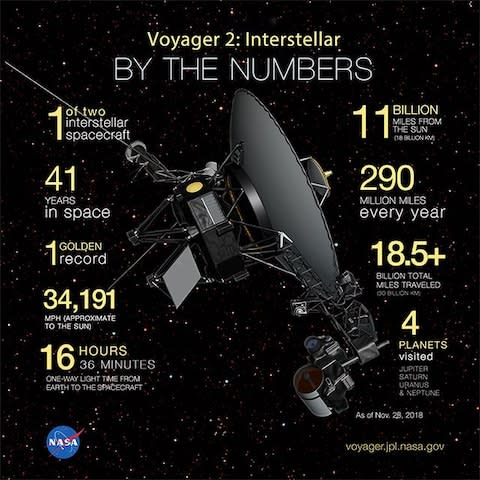Voyager 2 leaves Solar System, becoming only second man-made object to enter interstellar space

The Voyager 2 probe has left the Solar System, Nasa has confirmed, becoming only the second man-made object to ever enter interstellar space.
The spacecraft left Earth in 1977, 16 days before its twin Voyager 1, but the later probe ended up travelling faster after gaining a gravity boost at Jupiter and Saturn and so exited the vast plasma bubble created by the Sun - known as the heliosphere - in 2012.
However, unlike its sister craft, Voyager 2 carries a working instrument called the Plasma Science Experiment (PLS) which will provide first-of-its-kind observations as it moves into the space between stars.
“Working on Voyager makes me feel like an explorer, because everything we’re seeing is new,” said John Richardson, principal investigator for the PLS instrument and a principal research scientist of MIT, in Cambridge, US.
“Even though Voyager 1 crossed the heliopause in 2012, it did so at a different place and a different time, and without the PLS data. So we’re still seeing things that no one has seen before.”
The probe also has three other working instruments on board, the cosmic ray subsystem, the low energy charged particle instrument and the magnetometer, which can be used to get a picture of the environment that Voyager 2 is travelling through.
“There is still a lot to learn about the region of interstellar space immediately beyond the heliopause,” said Ed Stone, Voyager project scientist based at Caltech in Pasadena, California.
Voyager 2 now is slightly more than 11 billion miles (18 billion kilometers) from Earth and communications take 16.5 hours to travel between mission controllers and the probe.
Both the probes are powered using heat from the decay of radioactive material, contained in a device called a radioisotope thermal generator (RTG). Their original five-year lifespans have stretched to 41 years, making Voyager 2 NASA’s longest running mission.

However, there are different definitions of where the Solar System begins and ends. While many think the heliopause, outside the solar wind, marks the end, others say that the craft must pass through the Oort Cloud, a band of comets which are still trapped in the Sun’s gravitational pull.
It will take about 300 years for Voyager 2 to reach the inner edge of the Oort Cloud and possibly 30,000 years to fly beyond it.
“I think we’re all happy and relieved that the Voyager probes have both operated long enough to make it past this milestone,” said Suzanne Dodd, Voyager project manager at NASA’s Jet Propulsion Laboratory (JPL) in Pasadena, California.
“This is what we’ve all been waiting for. Now we’re looking forward to what we’ll be able to learn from having both probes outside the heliopause.”

 Yahoo News
Yahoo News 